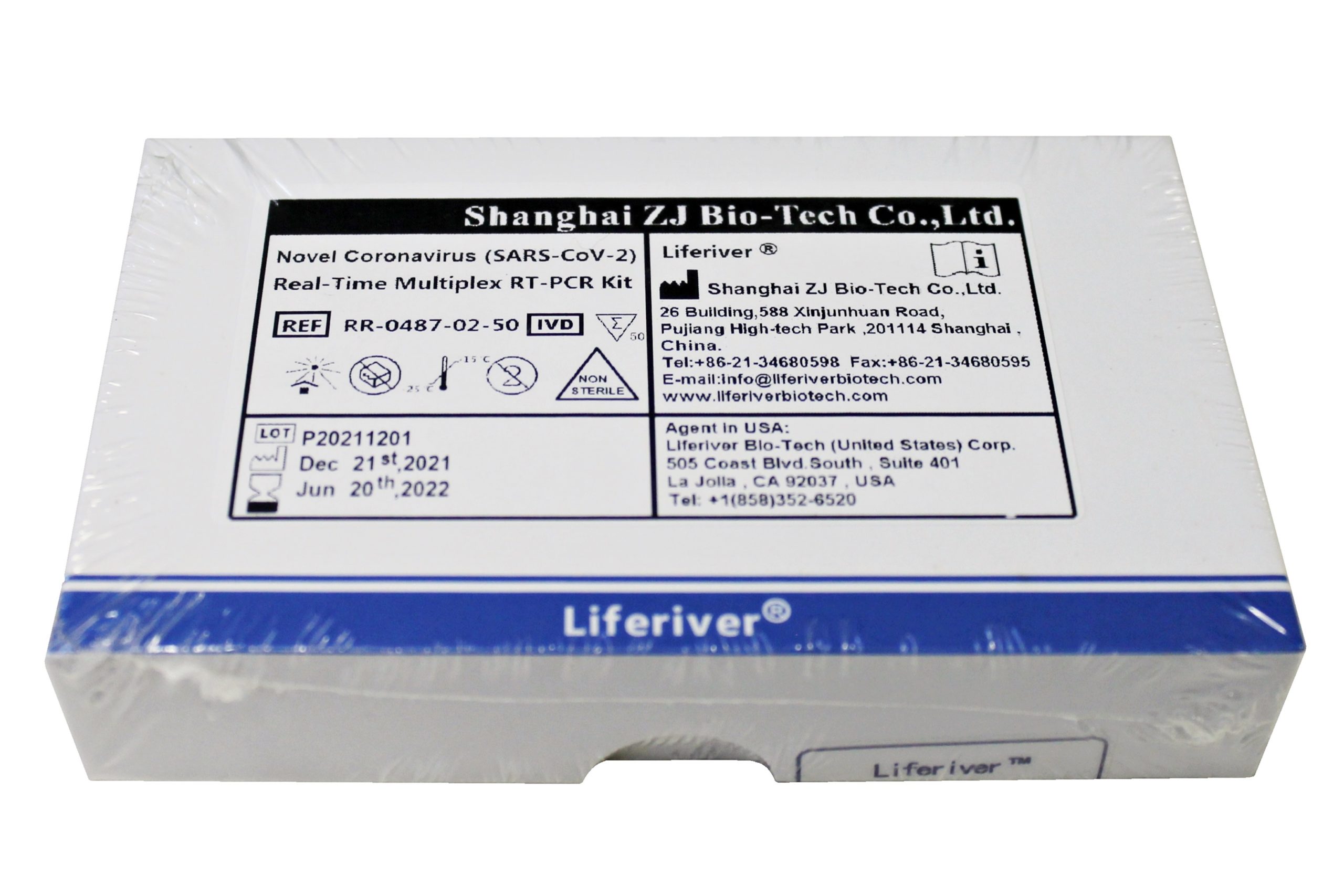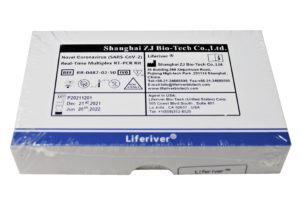
PRODUCT INFORMATION
Liferiver Novel Coronavirus (2019-nCoV) Real Time Multiplex RT-PCR Kit
Authorized under Interim Order (IO) in Canada and CE Marked

Each Kit Contains:
- 1 vial Molecular Grade Water
- 1 vial Combined Primer/Probe Mix
- 1 vial One-step RT-qPCR Master Mix
- 1 vial SARS-CoV-2 Internal Control
- 1 vial SARS-CoV-2 Negative Control
- 1 vial SARS-CoV-2 Positive Control
Intended Use: CLIA certified high-complexity laboratories or similarly qualified non-US laboratories by trained laboratory personnel who are proficient in performing real-time RT-PCR assays.
Specification:
- Sample Type: nasopharyngeal or oropharyngeal swabs and sputum
- Target: SARS-CoV-2 ORF1ab gene, N gene, and E gene
- Detection Method: RT-PCR
- Positive Agreement: 100 %
- Negative Agreement: 100 %
- Interim Order # 313701
- Store at -25 oC to -15 oC
- RNA extraction kit required (not provided)
The Novel Coronavirus (SARS-CoV-2) Real-Time Multiplex RT-PCR Kit is an in vitro diagnostic test for the presumptive qualitative detection of nucleic acid from the SARS-CoV-2 in upper and lower respiratory specimens (including nasopharyngeal or oropharyngeal swabs and sputum) collected from individuals as recommended for testing by public health authority guidelines. The product contains Super Mix, RT-PCR Enzyme Mix and control material used in rRT-PCR for the in vitro qualitative detection of SARS-CoV-2 RNA in respiratory specimens. Results are for the presumptive identification of SARS-CoV-2 RNA. The SARS-CoV-2 RNA is generally detectable in upper and lower respiratory specimens during infection. Positive results are indicative of active infection with SARS-CoV-2 but do not rule out bacterial infection or co-infection with other viruses. The agent detected may not be the definite cause of disease. Positive results might need to be reported in accordance with local regulations. Negative results do not preclude SARS-CoV-2 infection and should not be used as the sole basis for treatment or other patient management decisions. Negative results must be combined with clinical observations, patient history, and epidemiological information.
Background Information
On January 11, 2020, Chinese health authorities preliminarily identified more than 40 human infections with a novel coronavirus in an outbreak of pneumonia under investigation in Wuhan City, Hubei Province, China. The Chinese authorities identified a new type of coronavirus (novel coronavirus, named as SARS-CoV-2), which was isolated on January 7, 2020. By February 25, 2020, SARS-CoV-2 has resulted in more than 80,000 confirmed human infections in a number of countries globally, including close to 2,700 deaths. Symptoms of COVID-19 might include fever, cough, difficulty breathing, fatigue, sore throat, stuffy nose, body aches, headache, vomiting, diarrhea, loss of sense of smell or taste. The Novel Coronavirus (SARS-CoV-2) Real-Time Multiplex RT-PCR Kit is a molecular in vitro diagnostic test that aids in the detection and diagnosis of SARS-CoV-2 and is based on widely used real-time RT-PCR technology utilizing reverse-transcriptase (RT) reaction to convert RNA into complementary DNA (cDNA) and nucleic acid amplification technology.
Principle
Three sets of oligonucleotide primers and probes for detection of SARS-CoV-2 were selected respectively from regions of the virus ORF1ab gene, N gene and E gene. An additional primer/probe set to detect the internal control gene processed with the clinical specimens is also included in the kit. RNA isolated and purified from upper and lower respiratory specimens is reverse transcribed to cDNA and subsequently amplified in the real-time PCR instrument. In the process, the probe anneals to a specific target sequence located between the forward and reverse primers. During the extension phase of the PCR cycle, the 5’ nuclease activity of Taq polymerase degrades the probe, causing the reporter dye to separate from the quencher dye, generating a fluorescent signal. With each cycle, additional reporter dye molecules are cleaved from their respective probes, increasing the fluorescence intensity. Fluorescence intensity is monitored at each PCR cycle by real-time PCR system. Detection of viral RNA not only aids in the diagnosis of illness but also provides epidemiological and surveillance information.


